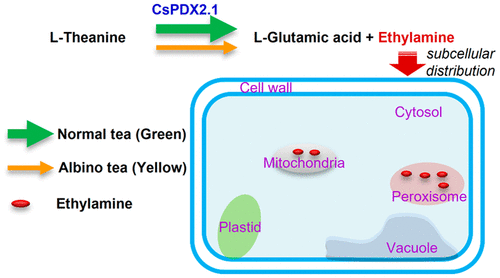当前位置:
X-MOL 学术
›
J. Agric. Food Chem.
›
论文详情
Our official English website, www.x-mol.net, welcomes your
feedback! (Note: you will need to create a separate account there.)
Characterization of l-Theanine Hydrolase in Vitro and Subcellular Distribution of Its Specific Product Ethylamine in Tea (Camellia sinensis).
Journal of Agricultural and Food Chemistry ( IF 5.7 ) Pub Date : 2020-08-31 , DOI: 10.1021/acs.jafc.0c01796 Xiumin Fu 1 , Sihua Cheng 1, 2 , Yinyin Liao 1, 2 , Xinlan Xu 1 , Xinchao Wang 3 , Xinyuan Hao 3 , Ping Xu 4 , Fang Dong 5 , Ziyin Yang 1, 2, 6
Journal of Agricultural and Food Chemistry ( IF 5.7 ) Pub Date : 2020-08-31 , DOI: 10.1021/acs.jafc.0c01796 Xiumin Fu 1 , Sihua Cheng 1, 2 , Yinyin Liao 1, 2 , Xinlan Xu 1 , Xinchao Wang 3 , Xinyuan Hao 3 , Ping Xu 4 , Fang Dong 5 , Ziyin Yang 1, 2, 6
Affiliation

|
l-Theanine has a significant role in the taste of tea (Camellia sinensis) infusions. Our previous research indicated that the lower l-theanine metabolism in ethylamine and l-glutamate is a key factor that explains the higher content of l-theanine in albino tea with yellow or white leaves, compared with that of normal tea with green leaves. However, the specific genes encoding l-theanine hydrolase in tea remains unknown. In this study, CsPDX2.1 was cloned together with the homologous ArabidopsisPDX2 gene and the recombinant protein was shown to catalyze l-theanine hydrolysis into ethylamine and l-glutamate in vitro. There were higher CsPDX2.1 transcript levels in leaf tissue and lower transcripts in the types of albino (yellow leaf) teas compared with green controls. The subcellular location of ethylamine in tea leaves was shown to be in the mitochondria and peroxisome using a nonaqueous fractionation method. This study identified the l-theanine hydrolase gene and subcellular distribution of ethylamine in tea leaves, which improves our understanding of the l-theanine metabolism and the mechanism of differential accumulation of l-theanine among tea varieties.
中文翻译:

l-茶氨酸水解酶的体外表征及其特定产物乙胺在茶树中的亚细胞分布。
l-茶氨酸在茶(茶花)注入物中的味道中具有重要作用。我们以往的研究表明,低升在乙胺和-theanine代谢升谷氨酸盐是解释含量较高的一个关键因素升-theanine与黄色或白色的叶子白化茶,与绿叶正常的茶相比。但是,尚不清楚茶中编码1-茶氨酸水解酶的特定基因。在这项研究中,CsPDX2.1与同源拟南芥PDX2基因一起被克隆,重组蛋白被证明可以催化1-茶氨酸水解为乙胺和升-谷氨酸体外。与绿色对照组相比,白化病(黄叶)茶的叶片组织中的CsPDX2.1转录水平较高,而白化茶类型的转录水平较低。使用非水分离方法显示,乙胺在茶叶中的亚细胞位置位于线粒体和过氧化物酶体中。这项研究确定了升-theanine水解酶基因和乙胺的亚细胞分布在茶叶,从而提高我们的认识升-theanine代谢和差的积累机制升-theanine茶树品种之一。
更新日期:2020-09-30
中文翻译:

l-茶氨酸水解酶的体外表征及其特定产物乙胺在茶树中的亚细胞分布。
l-茶氨酸在茶(茶花)注入物中的味道中具有重要作用。我们以往的研究表明,低升在乙胺和-theanine代谢升谷氨酸盐是解释含量较高的一个关键因素升-theanine与黄色或白色的叶子白化茶,与绿叶正常的茶相比。但是,尚不清楚茶中编码1-茶氨酸水解酶的特定基因。在这项研究中,CsPDX2.1与同源拟南芥PDX2基因一起被克隆,重组蛋白被证明可以催化1-茶氨酸水解为乙胺和升-谷氨酸体外。与绿色对照组相比,白化病(黄叶)茶的叶片组织中的CsPDX2.1转录水平较高,而白化茶类型的转录水平较低。使用非水分离方法显示,乙胺在茶叶中的亚细胞位置位于线粒体和过氧化物酶体中。这项研究确定了升-theanine水解酶基因和乙胺的亚细胞分布在茶叶,从而提高我们的认识升-theanine代谢和差的积累机制升-theanine茶树品种之一。






























 京公网安备 11010802027423号
京公网安备 11010802027423号